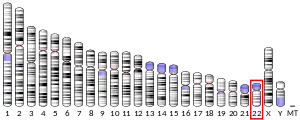DGCR8
DGCR8全稱為迪喬治症候群關鍵區域8(DiGeorge syndrome critical region 8)是哺乳類的一個蛋白質,在人類基因組中由22號染色體上的DGCR8基因編碼[4]。模式生物黑腹果蠅與秀麗隱桿線蟲與此同源的基因名為Pasha,意為「Drosha蛋白的夥伴」(partner of Drosha)[5]。
| DGCR8 | |||||||||||||||||||||||||
|---|---|---|---|---|---|---|---|---|---|---|---|---|---|---|---|---|---|---|---|---|---|---|---|---|---|
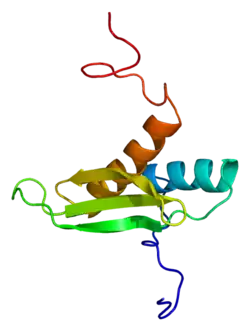 | |||||||||||||||||||||||||
| |||||||||||||||||||||||||
| 識別號 | |||||||||||||||||||||||||
| 别名 | DGCR8;, C22orf12, DGCRK6, Gy1, pasha, Pasha, DGCR8 microprocessor complex subunit, microprocessor complex subunit | ||||||||||||||||||||||||
| 外部ID | OMIM:609030 MGI:2151114 HomoloGene:11223 GeneCards:DGCR8 | ||||||||||||||||||||||||
| |||||||||||||||||||||||||
| RNA表达模式 | |||||||||||||||||||||||||
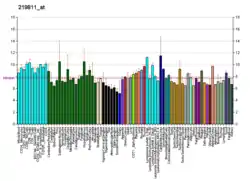 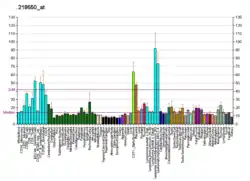 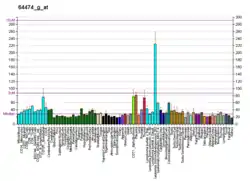 | |||||||||||||||||||||||||
| 查阅更多表达数据 | |||||||||||||||||||||||||
| 直系同源 | |||||||||||||||||||||||||
| 物種 | 人類 | 小鼠 | |||||||||||||||||||||||
| Entrez | |||||||||||||||||||||||||
| Ensembl | |||||||||||||||||||||||||
| UniProt | |||||||||||||||||||||||||
| mRNA序列 | |||||||||||||||||||||||||
| 蛋白序列 | |||||||||||||||||||||||||
| 基因位置(UCSC) | Chr 22: 20.08 – 20.11 Mb | 无数据 | |||||||||||||||||||||||
| PubMed查找 | [2] | [3] | |||||||||||||||||||||||
| 維基數據 | |||||||||||||||||||||||||
功能
DGCR8位於細胞核中,參與miRNA前驅物(pri-miRNA)的切割,此蛋白可與Drosha(一種核糖核酸酶Ⅲ)結合,組成微加工複合體,將由DNA轉錄產生的pri-miRNA切割成長約70nt的pre-miRNA,後者可再由Dicer切割產生成熟的miRNA。DGCR8有一可與RNA結合的結構域,可與pri-miRNA結合以穩定其結構,以利Drosha進行切割[6]。Drosha一般需在與DGCR8結合的情況下才能進行切割[7]。
此外DGCR8也參與部分DNA修補的途徑,DGCR8的一個位點被磷酸化後可參與转录偶联修复(transcription coupled nucleotide excision repair,簡稱TC-NER,用於移除嘧啶二聚體等紫外線造成的DNA損傷)以及核苷酸切除修復(NER,移除過氧化氫等化學物質造成的DNA氧化損傷)等,且此機制與DGCR8和Drosha結合以及和RNA結合的能力均無關[8]。
參考文獻
- GRCh38: Ensembl release 89: ENSG00000128191 - Ensembl, May 2017
- . National Center for Biotechnology Information, U.S. National Library of Medicine.
- . National Center for Biotechnology Information, U.S. National Library of Medicine.
- . (原始内容存档于2010-12-05).
- Denli AM, Tops BB, Plasterk RH, Ketting RF, Hannon GJ. . Nature. Nov 2004, 432 (7014): 231–5. PMID 15531879. doi:10.1038/nature03049.
- Yeom KH, Lee Y, Han J, Suh MR, Kim VN. . Nucleic Acids Research. 2006, 34 (16): 4622–9. PMC 1636349
 . PMID 16963499. doi:10.1093/nar/gkl458.
. PMID 16963499. doi:10.1093/nar/gkl458. - Han J, Lee Y, Yeom KH, Nam JW, Heo I, Rhee JK, Sohn SY, Cho Y, Zhang BT, Kim VN. . Cell. 2006, 125 (5): 887–901. PMID 16751099. S2CID 453021. doi:10.1016/j.cell.2006.03.043
 .
. - Calses PC, Dhillon KK, Tucker N, Chi Y, Huang JW, Kawasumi M, Nghiem P, Wang Y, Clurman BE, Jacquemont C, Gafken PR, Sugasawa K, Saijo M, Taniguchi T. . Cell Rep. 2017, 19 (1): 162–174. PMC 5423785
 . PMID 28380355. doi:10.1016/j.celrep.2017.03.021.
. PMID 28380355. doi:10.1016/j.celrep.2017.03.021.
This article is issued from Wikipedia. The text is licensed under Creative Commons - Attribution - Sharealike. Additional terms may apply for the media files.
